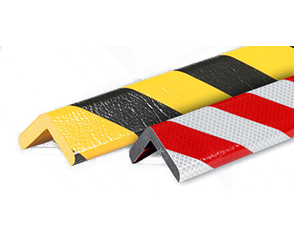Vinyl
Click below for pertinent facts and informational links for the materials that our corner guards are made from.
Vinyl corner guards are extruded and so cannot be produced with custom size sides. For example, we cannot form 1.5’’ x 2.75’’ sides but we can cut the products down to custom lengths from 120’’ down. These products are not UAV rated and are not intended for exterior use. If installed in an exterior location, these products will discolor and crack.
What size corner guards do we carry?
3/4″ | 1 1/8″ | 1 1/2″ | 2″ | 2 1/2″ | 3″ |
What is the tolerance on a specialty cut length?
+1/4″
What material is used for textured vinyl corner guards?
TheCornerGuardStore produces vinyl corner guards from top UL fire-rated material.
Will these corner guards work on a knock down textured wall?
The textured vinyl with the foam tape would work better.
Can we make a bullnose stainless steel corner guard?
No
More information on Vinyl
From Wikipedia: https://en.wikipedia.org/wiki/Vinyl_group
In chemistry, vinyl or ethenyl[1] (abbreviated as Vi[2]) is the functional group with the formula −CH=CH2. It is the ethylene (IUPAC ethene) molecule (H2C=CH2) less one hydrogen atom. The name is also used for any compound containing that group, namely R−CH=CH2 where R is any other group of atoms.
An industrially important example is vinyl chloride, precursor to PVC, a plastic commonly known as vinyl.
Vinyl is one of the alkenyl functional groups. On a carbon skeleton, sp2-hybridized carbons or positions are often called vinylic. Allyls, acrylates and styrenics contain vinyl groups. (A styrenic crosslinker with two vinyl groups is called divinyl benzene.)
https://en.wikipedia.org/wiki/Polyvinyl_chloride
Polyvinyl chloride (/ˌpɒlivaɪnəl ˈklɔːraɪd/;[5] colloquial: polyvinyl, vinyl;[6] abbreviated: PVC) is the world's third-most widely produced synthetic plastic polymer, after polyethylene and polypropylene.[7] About 40 million tonnes are produced per year.
PVC comes in two basic forms: rigid (sometimes abbreviated as RPVC) and flexible. The rigid form of PVC is used in construction for pipe and in profile applications such as doors and windows. It is also used in making bottles, non-food packaging, food-covering sheets,[8] and cards (such as bank or membership cards). It can be made softer and more flexible by the addition of plasticizers, the most widely used being phthalates. In this form, it is also used in plumbing, electrical cable insulation, imitation leather, flooring, signage, phonograph records,[9] inflatable products, and many applications where it replaces rubber.[10] With cotton or linen, it is used to make canvas.
Pure polyvinyl chloride is a white, brittle solid. It is insoluble in alcohol but slightly soluble in tetrahydrofuran.
Key Properties
Vinyl is often chosen over other materials because of its low cost, versatility and performance properties. Vinyl is strong, durable, abrasion and moisture resistant; withstands rust and corrosion; is electrically non-conductive and has excellent fire performance properties.
What kind of material is vinyl?
Vinyl is not a natural substance but is a synthetic man-made material. It is a type of plastic that is made from ethylene (found in crude oil) and chlorine (found in regular salt). When processed, both the substances are combined to form Polyvinyl Chloride (PVC) resin, or as is commonly referred to - Vinyl
Is vinyl and PVC the same thing?
Vinyl is a radical of ethane that refers to many different ethylene-based compounds and PVC is polyvinyl chloride and a polymer of vinyl chloride. PVC is a type of vinyl and is one of the most popular construction materials on the market. PVC stands for polyvinyl chloride and is relatively inexpensive.
What is PVC what are its properties and uses?
Polyvinyl Chloride (PVC or Vinyl) is an economical and versatile thermoplastic polymer widely used in building and construction industry to produce door and window profiles, pipes (drinking and wastewater), wire and cable insulation, medical devices etc.
Is vinyl cancerous?
Polyvinyl chloride (PVC or vinyl) is the most toxic plastic for our health and the environment. ... During its lifecycle — from production to use to disposal — vinyl releases some of the most toxic chemicals on the planet that have been linked to cancer, birth defects and other serious chronic diseases.
Is PVC cancerous?
PVC contains harmful carcinogens, most notably VCM. Other chemicals such as dioxin and phthalates, both carcinogenic, may also be released into an indoor environment, endangering the people who work and live in buildings that use PVC. ... Phthalates are carcinogenic chemicals often used in plastics to make them flexible.
Is PVC waterproof?
What is PVC? Don't let the code-like name put you off here – this material may seem scary by title, but it is purely waterproof-friendly by nature. There are two materials that are used in PVC Mesh: ... Polyester is a 'hydrophobic' material, meaning that it is naturally quick drying, so it can be used for insulation.
Is PVC rubber or plastic?
PVC is a type of plastic incorporating vinyl groups. This makes it lighter than rubber and more affordable, but it comes with some stiffness in comparison to rubber too. It can be sharp and harsh at the edges, causing discomfort against skin. In addition, it is also less durable than rubber, which is to be expected.
|
Material |
Chemical |
Warning |
|
Vinyl |
Vinyl Chloride |
|












